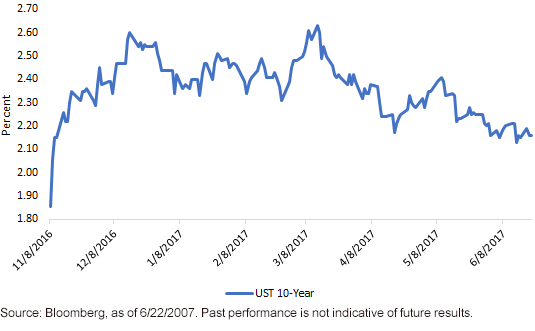Shortening Duration, Getting a Second Chance


We’re six months into 2017, and investors have begun asking themselves, did rates peak yet again or will there be another leg to the upside in the second half of the year? In my opinion, the question probably needs a longer time horizon than just the upcoming July–December period. Indeed, volatility in the intermediate to longer-dated sector of the U.S. Treasury (UST) market has been on full display over the last year (especially since Election Day), and a prudent fixed income strategy needs to filter out the noise and focus on where the most likely landing place will be for UST yields over a more extended investment horizon.
2017 certainly started off as anticipated, as the UST 10-Year yield moved to a high watermark of 2.63% in mid-March, the highest reading in about three years. However, since then, the yield level has reversed course, moving on a descending trajectory to reach a low point of 2.13% only three months later (i.e., two weeks ago), the lowest level since the day after the U.S. election. This 50 basis point (bps) reversal came in the wake of two Fed rate hikes and guidance from policy makers that the goal is to begin normalizing their balance sheet later this year. Now, conventional wisdom would lead one to believe that a Treasury market rally of the magnitude investors just witnessed would be the least likely of all rate outcomes. So, what next?
UST 10-Year Yield Post-Election

Our base case for this year was for the Federal Reserve (Fed) to deliver two to three rate hikes and the UST 10-Year yield to reside in the 2.25%–3.00% range. Thus far, the Fed has delivered on its end of the bargain, but some modest adjustments will probably be in order for the UST 10-Year yield. First up, it’s important to mention that the bear and bull cases where the extreme ranges could have been 1.50% (bull) and 3.50% (bear) seem unlikely as of this writing—but as we’ve seen over the past few years, stranger things have happened. Nevertheless, that brings us back more to the base case scenario. In this outlook, we acknowledge the aforementioned low point of just under 2.15%, but at the other end of the spectrum, we would envision the upside more in the area of 2.50%–2.75%, with the top of the range likely being realized after Labor Day.
Conclusion
In my opinion, the UST market is giving fixed income investors a second chance at preparing their portfolios for the potential of higher rates later this year. The Fed seems poised to deliver on the front end, and if our base case comes to fruition, the intermediate to longer portion of the yield curve will witness some upward pressure as well. Against this backdrop, investors may wish to consider reducing some duration in their core fixed income in order to lessen the sensitivity for potentially higher rates. The WisdomTree Yield Enhanced U.S. Short-Term Aggregate Bond Fund (SHAG) offers investors the ability to reduce duration while still focusing on income. This Fund can be used as a stand-alone core position or as a complement to an overall fixed income portfolio.
Unless otherwise noted, data source is the Federal Reserve, as of 6/22/2017.
Important Risks Related to this Article
There are risks associated with investing, including possible loss of principal. Fixed income investments are subject to interest rate risk; their value will normally decline as interest rates rise. Fixed income investments are also subject to credit risk, the risk that the issuer of a bond will fail to pay interest and principal in a timely manner, or that negative perceptions of the issuer’s ability to make such payments will cause the price of that bond to decline. Investing in mortgage- and asset-backed securities involves interest rate, credit, valuation, extension and liquidity risks and the risk that payments on the underlying assets are delayed, prepaid, subordinated or defaulted on. Due to the investment strategy of the Fund, it may make higher capital gain distributions than other ETFs. Please read the Fund’s prospectus for specific details regarding the Fund’s risk profile.

